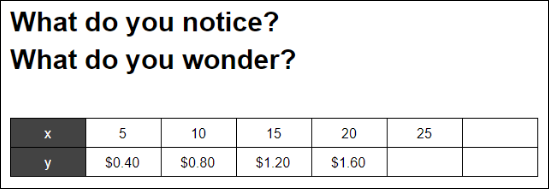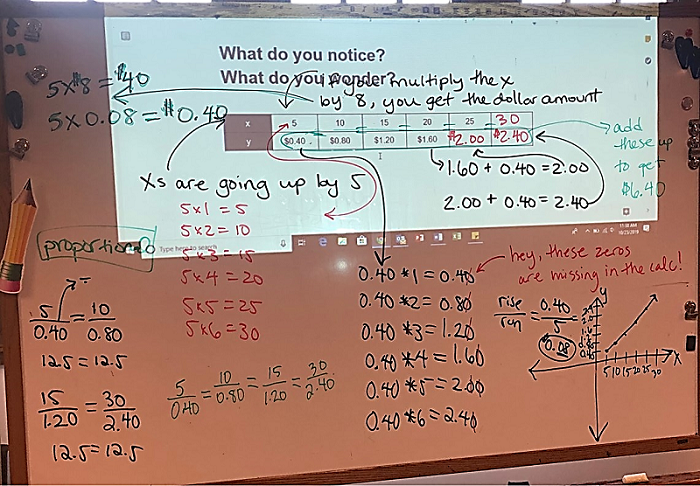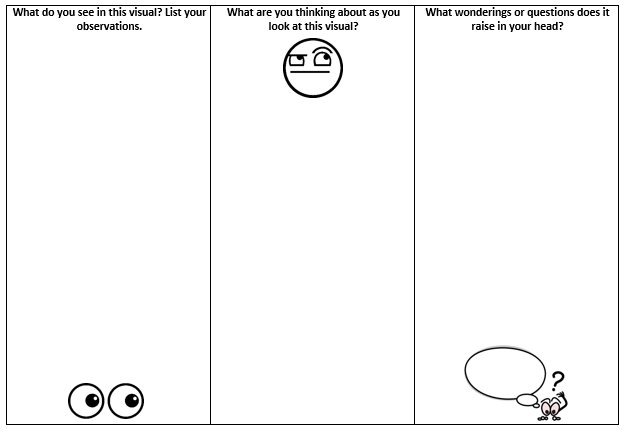- MN ABE Connect
- Archive
- Making Thinking Visible in Math and ELA Instruction: Part 2
 January 21, 2020
January 21, 2020
Making Thinking Visible in Math and ELA Instruction: Part 2
Lindsey Cermak, Numeracy Coordinator Kristine Kelly, Literacy & ELA CoordinatorIn last week’s newsletter, we shared our first article on making thinking in the classroom visible. As a reminder from that article, we need to empower our learners to be able to make their thinking visible more efficiently. It is up to us to employ strategies in the classroom that model how to make thinking visible and create spaces for learners to share their ideas in new ways.
To draw these types of thinking out of students, we will be describing one strategy each in our next three articles. All three strategies are appropriate for the math and/or ELA classroom.
Strategy 1: Notice-Wonder/See-Think-Wonder
These strategies are an excellent way to elicit students’ thoughts and knowledge on a topic. Notice-Wonder and See-Think-Wonder prompts are low-floor, high-ceiling tasks since students are able to enter into the conversation wherever they are comfortable – with whatever they notice/see, think, and wonder.
In math, this activity commonly takes the form of Notice-Wonder:
- What do you notice? (or What do you see/observe?)
- What do you wonder? (or What questions do you have? What things does this make you think about?)
By choosing any graph, chart, visual pattern, math statement, etc., and asking learners these two simple questions, groundwork is laid for an incredibly rich discussion that is directed by learners’ own thoughts and ideas.
Below is an example of a Notice-Wonder blank prompt that Lindsey recently used in her classroom. The second picture is a snapshot of the discussion that followed afterward – primarily driven by her students’ observations. Her job as the teacher was to capture what they were saying and express it on the board. By doing this, she modeled how to make their thinking visible.


Similarly in ELA, with See-Think-Wonder, you can ask questions about a photo, cartoon, chart or graph, work of art, etc:
- What do you see?
- What do you think about it?
- What does it make you wonder?
This next picture is an example of a See-Think-Wonder activity Kristine did with her GED/diploma class as part of a unit with the line of inquiry “Should parents monitor their kids online?” The responses are to a political cartoon about kids, school, and technology. Students called out their responses, and Kristine recorded them on flipchart paper. The discussion that followed about their “wonder” questions created a lot of motivation for the unit!

Students could also record their responses first on their own handout like this, individually, in pairs, or in a small group:

Whether doing Notice-Wonder or See-Think-Wonder, prompting students to generate their own ideas helps students separate observations and interpretations (an important workplace skill!). These prompts also spark curiosity, deepen interest in the topic at hand, and help students create new connections. These questions are ideal for both ELA and Math classes since they work for both a group or individual setting, they may be done orally or on paper, and they are great for multilevel classrooms!
For more information, check out the archived MN CCRS TA webinar from October 31, 2019: Making Thinking Visible. It is archived on our MN ABE Professional Development YouTube channel (http://tinyurl.com/mnabepd).
Join us at the beginning of February when we discuss another great strategy for ELA and/or math: Chalk Talk!
Newsletter Signup
Get MN ABE Connect—the official source for ABE events, activities, and resources!
Sign UpArticle Categories
- ABE Foundations/Staff Onboarding
- ACES/Transitions
- Adult Career Pathways
- Assessment
- CCR Standards
- Citizenship
- COVID-19
- Cultural Competency
- Digital Literacy/Northstar
- Disabilities
- Distance Learning/Education
- ELA
- Equity/Inclusion
- ESL
- HSE/Adult Diploma
- Listening
- Math/Numeracy
- Mental Health
- Minnesota ABE
- One-Room Schoolhouse/Multilevel
- Professional Development
- Program Management
- Reading
- Remote Instruction
- Science
- Social Studies
- Speaking/Conversation
- Support Services
- Teaching Strategies
- Technology
- Uncategorized
- Volunteers/Tutors
- Writing